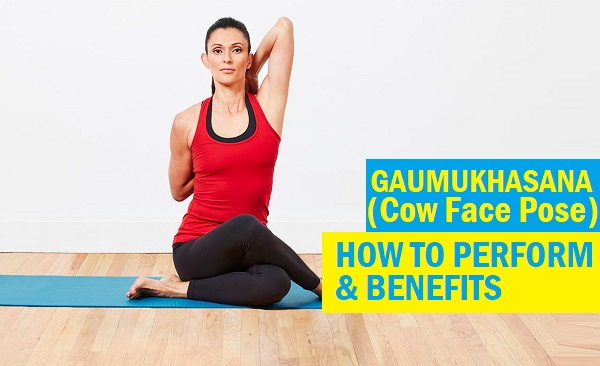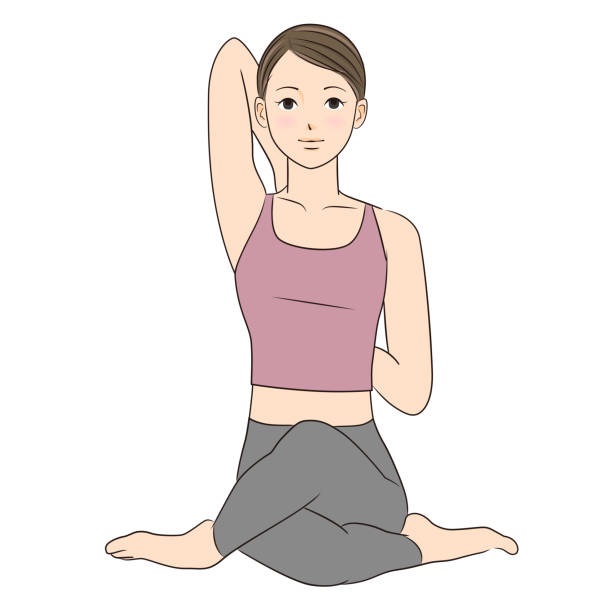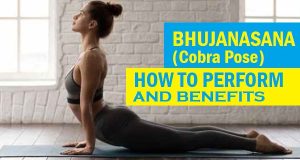
Gomukhasana (Cow Face Pose): Step-by-Step Guide, Benefits, Precautions, and FAQs
Gomukhasana, often referred to as the Cow Face Pose, is a well-known yoga posture with numerous benefits for both the body and mind. This asana resembles the face of a cow and is known for its numerous physical and mental benefits. Whether you’re a seasoned yogi or a beginner looking to explore yoga, Gomukhasana is a posture worth incorporating into your practice.
Step-by-Step Guide to Perform Gomukhasana
- Begin in a seated position on your yoga mat.
- Start with your legs extended in front of you, ensuring your spine is erect and your shoulders relaxed.
- Cross your legs. Bend your left leg and place it under your right thigh.
- Then, Gently bend the right leg and place it over the left thigh, stacking your knees as much as possible.
- Position your arms.
- Extend your right arm over your head and bend your elbow, reaching your hand down between your shoulder blades.
- Simultaneously, bring your left arm behind your back, bending your elbow, and reach upward to hold your right hand.
- Clasp your hands and If possible, try to clasp your hands together.
- If your hands don’t meet, you can hold onto a strap, towel, or a similar prop.
- Maintain your posture.
- Sit evenly on your sit bones, lengthening your spine with each inhale and gently twisting your torso with each exhale.
- Hold the pose.
- Stay in this position for about 30 seconds to 1 minute, breathing deeply and maintaining the stretch on both sides of your body.
Benefits of Gomukhasana
Gomukhasana is a traditional yoga pose that holds significance in the practice. It is often associated with opening and stretching the shoulders, chest, hips, and thighs. Additionally, the pose also promotes mindfulness and deep breathing. Gomukhasana offers a wide range of benefits that contribute to both physical and mental well-being. In fact, the posture engages multiple joints, promoting better blood circulation and ensuring the body receives enhanced nutrition and oxygen. Let’s explore the multiple benefits of this pose that contribute to a healthier and more vibrant lifestyle.
Elevating Body Posture and Muscle Strength
One of the key benefits of Gomukhasana is its positive impact on body posture. By stretching and strengthening the muscles in the ankles, knees, chest, and shoulders, this pose aligns the body and promotes an upright posture. Most importantly, the engagement of various joints enhances blood flow, preventing potential injuries in areas such as the ankles, chest, back, and shoulders.
Alleviating Sciatica Pain
Gomukhasana holds the potential to alleviate sciatica pain, which stems from compression and irritation of the sciatic nerve. This nerve travels from the lower back through the buttocks to the leg. To be precise, by lengthening and stretching the spine, Gomukhasana can provide relief from sciatic nerve discomfort.
Nurturing Kidney Health
A significant benefit of Gomukhasana is its positive influence on kidney function, which is one of the reasons to perform it daily. Several clinical studies have indicated that this asana promotes proper kidney function and reduces the risk of kidney stone formation. But how it’s done? Well! through increased urination frequency, toxins and unwanted materials are flushed out, supporting kidney health.
Empowering Diabetes Prevention
Regular practice of Gomukhasana contributes to improved insulin production in the body. This is true! This aids in slowing down the absorption of sugar in the blood, a pivotal factor in diabetes prevention. Researchers recommend this pose as part of a holistic approach for individuals dealing with diabetes.
Enhancing Sexual Performance and Vitality
Gomukhasana offers benefits beyond physical health, including its positive impact on sexual performance. The compression of sex organs during this pose stimulates the production of sex hormones, improves blood circulation, and enhances overall sexual vitality. Additionally, the strengthening of hips, calves, and thigh muscles plays a role in sexual well-being.
Embracing Stress Relief and Calm
In our fast-paced lives, stress and anxiety are constant companions. Almost everyone is struggling with some kind of depression and anxiety. Gomukhasana provides an effective solution by combining physical practice with mental tranquility. The rhythmic breathing pattern in this yoga practice calms the mind, lowers blood pressure, and reduces stress symptoms. The next time, you feel anxious, try the yoga asana in the morning and feel much better.
Nurturing Cardiovascular Health
Regular practice of Gomukhasana is associated with improved cardiovascular health. By opening the chest muscles, blood circulation is enhanced, reducing the strain on blood vessels and preventing the accumulation of fat and cholesterol. This yoga pose contributes to the prevention of cardiovascular diseases such as heart attacks and strokes.
Cultivating Muscular Flexibility
Gomukhasana works its magic on various muscle groups, stretching the ankles, knees, shoulders, and chest. This targeted stretching enhances blood flow to these areas, supplying muscles with increased oxygen and nutrition. Practicing the pose regularly also aids in injury prevention during physical activities.
Targeting Sciatica Treatment
For those struggling with sciatica, Gomukhasana can be a natural remedy. By lengthening the spine and alleviating compression on the sciatic nerve, this pose contributes to the reduction of radiating pain in the lower back, thigh, and calves.
Easing Stiff Shoulders with Gomukhasana
Individuals with stiff shoulders can find relief through Gomukhasana. This pose releases tension and stiffness in the shoulder region, gradually enhancing flexibility and range of motion.
Aiding Sexual Well-being
Gomukhasana’s impact on sexual well-being extends to easing stiffness in the lower body, improving blood flow, and relieving stress. The combination of these factors contributes to a healthier and more satisfying sexual experience.
Support for Hydrocele Condition
For individuals dealing with hydrocele, a condition characterized by fluid-filled testicles and scrotal swelling, Gomukhasana offers support. The pose’s stretching and strengthening effects can provide relief to those affected by this condition.
Gomukhasana for Full Body Toning
Gomukhasana offers a comprehensive toning experience for the body. By engaging the hips, thighs, chest, shoulders, anterior deltoids, triceps, and lats, this pose contributes to the toning of major muscle groups.
Fostering Improved Posture
Gomukhasana’s focus on spine, shoulders, and chest muscles contributes to improved posture. As these muscles are stimulated and strengthened, the body’s natural alignment is enhanced.
Embracing Hip Mobility
This classic easy yoga pose acts as an efficient hip opener. The deep abductor stretch experienced during Gomukhasana enhances hip mobility, resulting in more relaxed hip muscles.
Precautions to Consider
While Gomukhasana offers numerous benefits, it’s essential to approach the pose with care. Consider the following precautions:
Knee or hip issues: If you have knee or hip injuries, perform the pose with caution and use props if needed.
Shoulder limitations: If you struggle to clasp your hands, use a strap to avoid straining your shoulders. Be cautious if you have shoulder pain or limitations.
Back problems: Individuals with back issues should modify the pose by keeping their back straight and not rounding it. If you experience back discomfort, focus on keeping your spine straight.

Exploring Variations Of Gomukhasana
Gomukhasana can be adapted to suit different levels of flexibility and experience. In this section of this article, we’ll know about the variations of Gomukhasana, specifically focusing on the standing and seated versions. These variations offer unique advantages and challenges, catering to practitioners of different levels.
1. Standing Gomukhasana Variation
Standing Gomukhasana is a variation that adds an element of balance and stability to the pose. While maintaining the signature arm position, practitioners stand upright, engaging their core muscles for support.
Step-by-Step Guide for Standing Gomukhasana
- Begin in a comfortable standing position.
- Reach your right arm over your head and bend the elbow, allowing your hand to reach between the shoulder blades.
- Extend your left arm behind your back, bending the elbow and reaching upward.
- If possible, clasp your fingers together or use a strap to connect the hands.
- Maintain a tall posture, engaging your core for stability.
- Hold the pose for several breaths before switching sides.
Benefits of Standing Gomukhasana
Improved Balance: The standing variation challenges balance, enhancing stability and focus.
Strengthened Core: Keeping the torso engaged while standing activates the core muscles.
Expanded Chest Opening: The arm position combined with the standing posture stretches the chest and shoulders deeply.
2. Seated Variation Gomukhasana
Seated Gomukhasana is the classic rendition of the pose. Practitioners sit on the floor, crossing their legs in a way that resembles the shape of a cow’s face.
Step-by-Step Guide for Seated Gomukhasana
- Begin this variation by sitting in a comfortable position on the yoga mat.
- Cross your legs, stacking the knees as much as possible.
- Lift your right arm over your head and bend the elbow, reaching your hand down between the shoulder blades.
- Extend your left arm behind your back, bending the elbow, and try to clasp your hands together.
- Keep your spine straight and your chest open as you hold the pose for several breaths.
Advantages of Seated Gomukhasana
Deep Hip Opening: The crossed legs position in seated Gomukhasana stretches the hips and thighs.
Shoulder Stretch: The intertwining of the arms behind the back provides a profound shoulder stretch.
Grounding and Relaxation: The seated posture allows for a sense of grounding and relaxation.
Standing and seated Gomukhasana variations offer unique advantages and contribute to a well-rounded yoga practice. Whether you’re looking to enhance balance, open your hips, or stretch your shoulders, these variations provide a comprehensive approach to overall well-being. As you explore these variations, remember that yoga is a personal journey, and embracing the benefits of both versions can enrich your practice and bring you closer to a harmonious mind-body connection.
Incorporating Gomukhasana into Your Routine
To make the most of Gomukhasana, consider these tips:
Warm-up: Practice some gentle stretches to prepare your shoulders, hips, and spine.
Consistency: Incorporate Gomukhasana into your regular yoga routine to experience its full benefits.
Patience: Flexibility takes time to develop, so be patient with yourself as you progress.
Breath Awareness and Mindfulness During the Pose
As you hold Gomukhasana, focus on your breath:
Inhale deeply through your nose, expanding your chest and ribcage.
Exhale slowly through your nose, feeling your body relax and soften.
Gomukhasana is not just a physical posture; it’s also an opportunity to practice mindfulness.
Pay attention to your body’s sensations and your breath.
Gomukhasana for Upper Body Flexibility
Regular practice can alleviate shoulder stiffness and improve mobility.
The pose opens the chest, counteracting the hunched posture caused by modern lifestyles.
Strengthening the Lower Back
The Cow Face Pose engages the lower back muscles:
It helps relieve tension and discomfort in the lumbar region.
A strong lower back supports overall spinal health.
Gomukhasana and Posture Alignment
Poor posture can lead to various issues:
Gomukhasana’s alignment benefits can counteract the effects of slouching.
The pose encourages an upright, confident posture.
Who Should Avoid Gomukhasana?
While Gomukhasana is generally safe, certain individuals should approach it with caution or avoid it:
People with severe knee or hip injuries.
Those with acute shoulder pain or injuries.
Pregnant individuals, especially in later stages.
Always consult a healthcare professional if you’re unsure.
Addressing Common Misconceptions
Misconceptions about Gomukhasana:
It’s not just for advanced yogis; modifications make it accessible for everyone.
Flexibility is a journey; progress at your own pace without forcing your body.
Gomukhasana, the Cow Face Pose, is a multifaceted yoga posture that offers physical, mental, and spiritual benefits. By incorporating this pose into your practice, you can enhance flexibility, promote mindfulness, and find balance in your journey towards well-being. Remember, yoga is a personal journey, so approach Gomukhasana with patience, curiosity, and a willingness to embrace both challenges and growth.
FAQs (Frequently Asked Questions)
Q: Can I practice Gomukhasana if I’m a beginner?
A: Absolutely! Start with modifications and gradually work towards the full pose.
Q: How often should I practice Gomukhasana?
A: Aim for a few times a week for noticeable improvements.
Q: Can Gomukhasana help with back pain?
A: Yes, regular practice can alleviate tension and discomfort in the lower back.
Q: Should I push through pain while doing this pose?
A: No, never push through pain. Stretch gently and breathe deeply.
Q: Is Gomukhasana suitable for pregnant women?
A: It’s advisable to avoid deep hip stretches during pregnancy; consult your doctor.
Q: Can I practice Gomukhasana if I’m a beginner?
A: Yes, beginners can start with the seated variation and gradually explore the standing variation.
Q: Which variation is better for shoulder flexibility?
A: Both variations target shoulder flexibility, but the seated version provides a deeper stretch.
Q: Can pregnant individuals practice Gomukhasana variations?
A: It’s advisable to consult a healthcare professional before attempting any yoga pose during pregnancy.
Q: How long should I hold each variation?
A: Aim for about 30 seconds to 1 minute on each side, gradually increasing the duration as you progress.
Q: Can Gomukhasana variations help with posture?
A: Yes, the shoulder-opening benefits of these variations can contribute to improved posture.
Q: Is Gomukhasana suitable for beginners?
A: Beginners can gradually explore Gomukhasana with proper guidance and modifications.
Q: Can Gomukhasana relieve sciatica pain completely?
A: Gomukhasana can alleviate radiating pain associated with sciatica by lengthening the spine and reducing compression on the sciatic nerve.
Q: Can Gomukhasana be practiced by individuals with cardiovascular issues?
A: It’s advisable to consult a healthcare professional before attempting Gomukhasana if you have cardiovascular concerns.
Q: Can Gomukhasana be integrated into daily practice?
A: Yes, integrating Gomukhasana into your routine can contribute to overall flexibility, strength, and well-being.
 Tips and Beauty Site about Skin care, Hair care, Health, weight loss and lifestyle tips
Tips and Beauty Site about Skin care, Hair care, Health, weight loss and lifestyle tips






